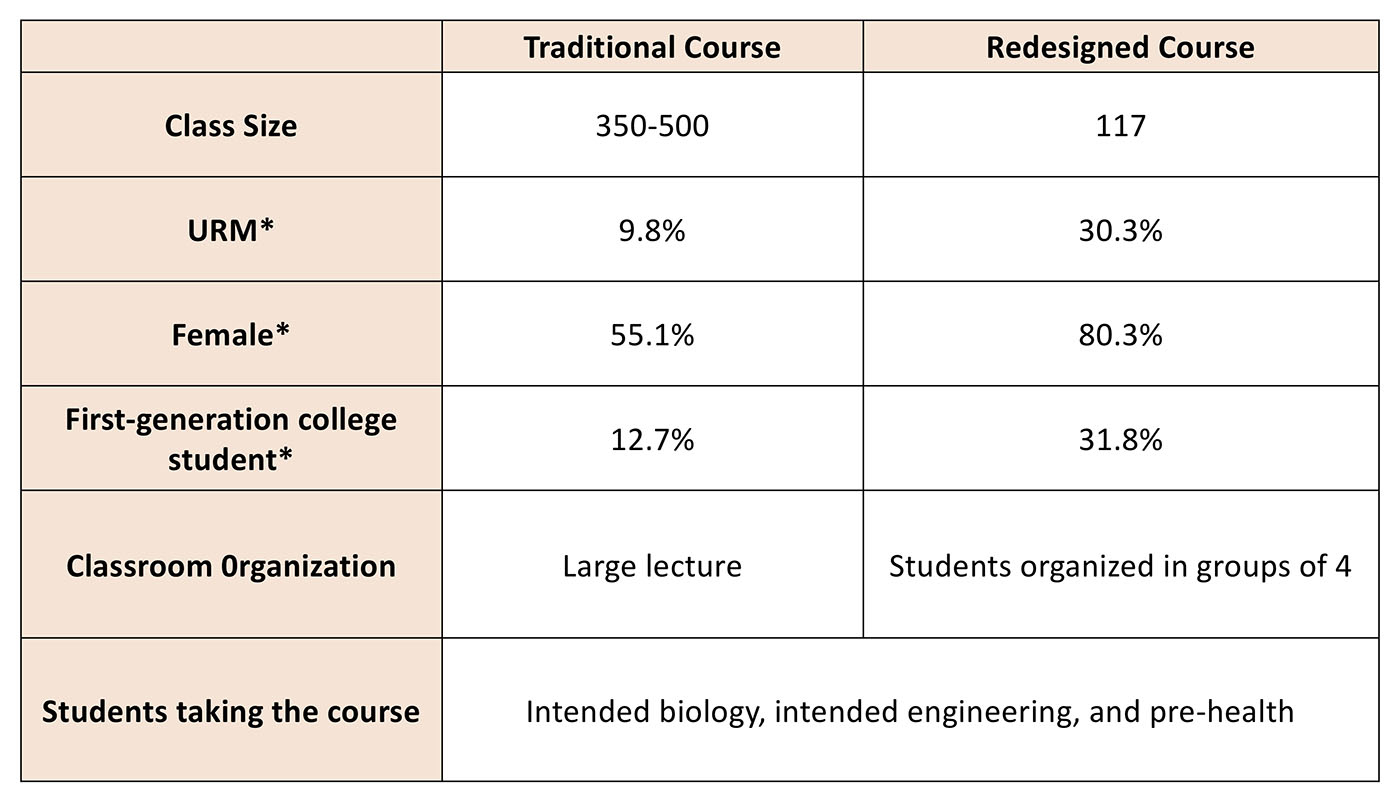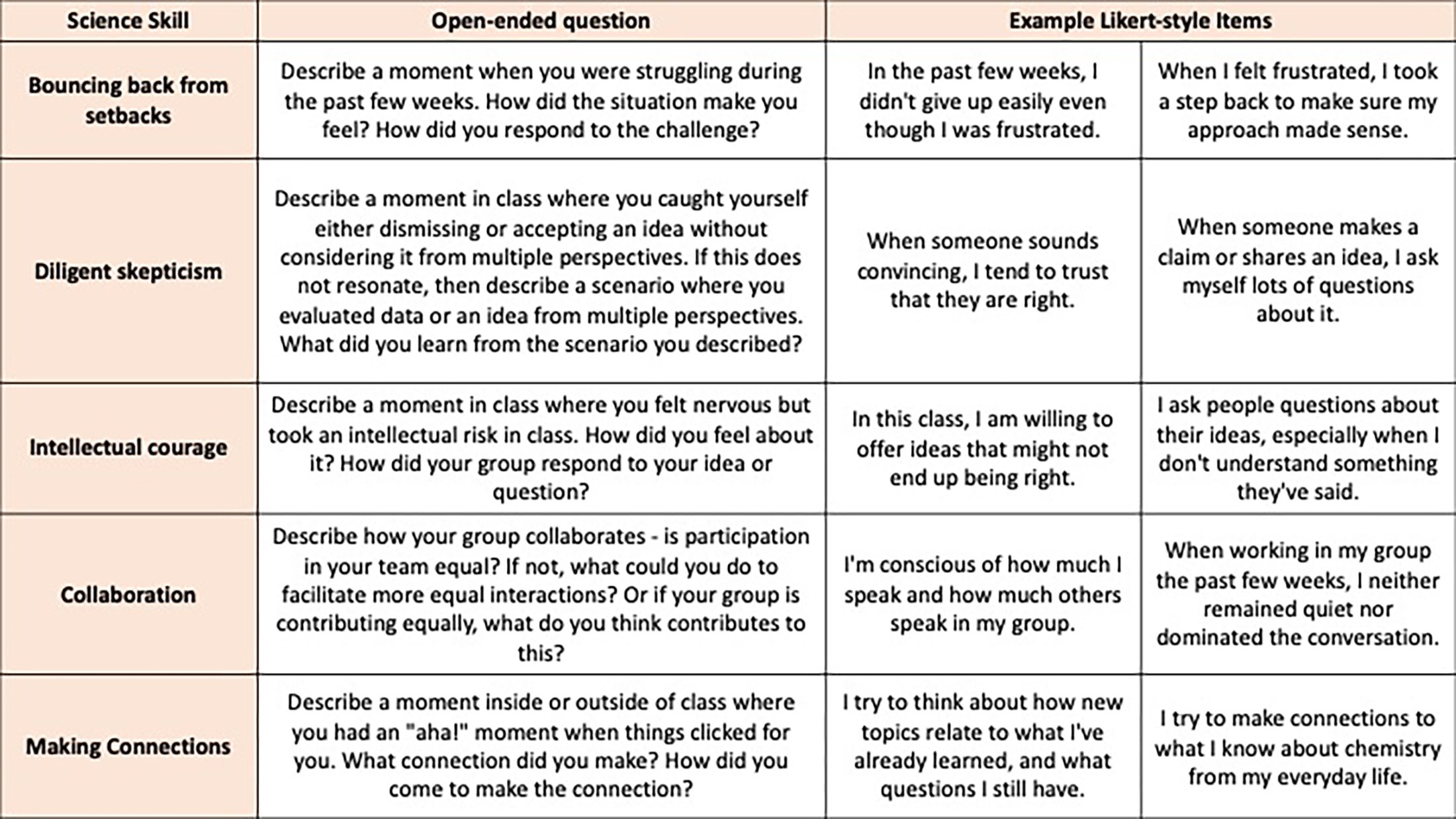feature
Designing to Disrupt Traditional Conceptions of Scientific Competence
Journal of College Science Teaching—September/October 2020 (Volume 50, Issue 1)
By Sabriya N. Rosemond, Erin S. Palmer, Kelly C. Y. Wong, Vishnu Murthy, and Angelica M. Stacy
Pervasive narratives about who and what counts as competent in science disproportionately impact students historically underrepresented in science, technology, engineering, and math (STEM), and are perpetuated in the design of STEM courses. Equity-focused education literature argues for the need to develop robust learning ecologies that support and develop the talents of all students. Here we describe the design of such an ecology in an introductory chemistry course at a large, public research university. The goals of the redesign were to: support students to see chemistry as an expansive and inclusive set of practices, define chemical competence explicitly as participation in these practices, and provide opportunities for students to engage in this new landscape throughout various aspects of the course. This holistic course redesign required the development of group-worthy, collaborative, in-class activities; complementary social supports alongside the creation of practice-centered assessments; and space for students to reflect on their relationship with chemistry as it shifted throughout the semester. We find that the structure of the in-class activities supports student engagement in scientific practices and that students who adopt a more expansive definition of what it means to be “good” at chemistry see themselves as such, irrespective of their grades.
Lee is a confident, high-achieving, young woman who enrolled in a large general chemistry course at a large, selective, public R1 university. Because she is Black, she neither looks like most students in the class of 500, nor does she fit the stereotypical phenotype of a scientist. In Figure 1A, Lee recalls a series of interactions that took place within the first two weeks of the semester, which led her to switch out of the traditional, lecture-based course she describes and into the pilot iteration of the redesigned course that is the subject of this paper.
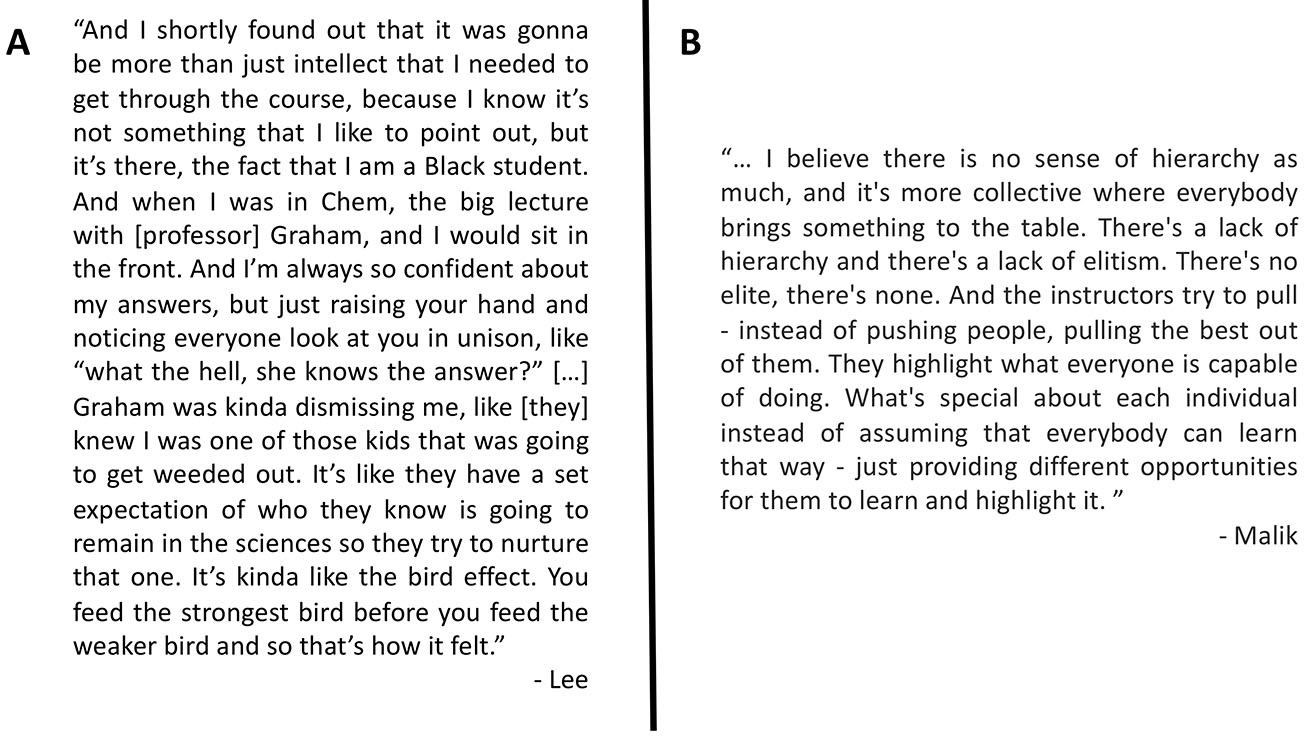
Student experiences in a chemistry course. Lee and Malik describe their experiences contending with hierarchies in two designs of the same introductory chemistry course. (A) Lee describes experiencing perceived microaggressions in the traditional course. (B) Malik, in the redesigned course, describes a course where the instructors are creating a space where all students’ competence is made visible and valued.
For marginalized students, participation in college science classrooms means navigating societal hierarchies that are reified in the classroom. Pervasive cultural narratives that link innate ability in science to race and gender inhibit marginalized students to see themselves as competent math and science learners (Nasir & Shah, 2011; Nasir et al., 2013). Furthermore, students enter these classrooms with an array of high school preparations (NCES, 2018). If the curriculum is not designed to attend to these differences, it means that some students will have more practice with the material than others, granting them easier access to participation. Equity-focused education scholarship has established that the ways students perceive themselves and are perceived by others is consequential for their participation and learning in science and math (Nasir et al., 2013). Therefore, even if these students are able to resist the racialized or gendered narratives, they still impact students’ access to learning and identity, as members of the classroom act in accordance with them (Nasir & Shah, 2011; Steele & Aronson, 1995). Here we describe the holistic redesign of an introductory chemistry course (described in Figure 1B) designed to mitigate these hierarchies by providing more expansive definitions of scientific competence that support students to see themselves as valued and competent science thinkers. We also share data that suggest that this explicit cultural work successfully supports students to see themselves as competent science learners.
In designing the course, we aimed to create an environment that socialized students into new ways of seeing and participating in science such that they are able to develop a rich, connected, and relevant understanding of chemistry, and recognize and build from the various ways that they are already scientifically competent. Traditional course design and assessment typically focus on asking students to provide the “right” answers phrased in the “right” way. This framing supports students to have a narrow definition of science, where science is a large, static body of discrete facts. This limited definition fosters an exclusionary understanding of what it means to be “good at science” and who can be seen as such (Carlone et al., 2011). Our redesign focused on providing an explicit, expansive, and more accurate, practice-based definition of science alongside ample opportunities to engage in scientific practices. Science was framed as: (1) a set of diverse practices employed to explore and explain the world, (2) an iterative process requiring creative problem-solving skills, and (3) a collaborative undertaking using the diverse perspectives, skills, and expertise available in teams of scientists. Additionally, we wanted students to develop an integrated understanding of chemistry that would allow them to make connections between what they were learning and the world around them. To achieve the desired shifts in students’ understanding of and relationship with science, we changed the entire organization of the course—curriculum, participation structures, language practices, assessments, and grading practices—and grounded the design in the following organizing principles: Communicate that scientific competence is about participation in scientific practices. Engage students in collaborative and individual scientific investigations. Support students to develop and use a connected understanding of science.
Nuts and bolts
The redesigned class met for three, 50-minute, in-class sessions per week and one weekly review session primarily led by the professor during a 15-week semester. Students have the option of taking the companion lab simultaneously or at a later time. The majority of students who take either the traditional or redesigned chemistry course (comparison in Table 1) intend to pursue careers in health, life science, environmental science, or engineering.
| Table 1. Comparison chart of traditional and redesigned course. | ||
|---|---|---|
|
Students were selected to participate in the redesigned course if they had a year or less of high school chemistry or if they were retaking the course. Demographic data collected from a survey of students suggests that there was an overrepresentation of underrepresented minorities (URM) and female students in the redesigned course, as compared to the population of the traditional course. There were 117 students enrolled in the redesigned course.
During class, students collaborated on activities—referred to as chemical tasks—in teams of four or five students. The first and last five minutes of class time was spent orienting students to and wrapping up the day’s activity via the task launch and closing. A multi-tiered instructional staff, which included a professor, two graduate student instructors, 10 undergraduate students, and two educational researchers, facilitated sustained collaborative engagement in chemical thinking and learning (see https://www.nsta.org/college/connections.aspx). A video lecture of varying time from 15–40 minutes was posted after each class, along with homework questions to support integration of ideas across the task and the lecture. Assessments included weekly quizzes, four exams, and a semester-long science communication project. Finally, students were asked to complete reflections to provide opportunities for them to make sense of their experience in this new learning system.
While covering the same material as the traditional course, we emphasized atomic models and potential and kinetic energy and made explicit connections to the ways that chemistry is relevant to everyday contexts to encourage students to develop a connected understanding of chemistry. Throughout the course, we provided supports for students to see how they can apply, refine, and expand chemistry models.
Designing an equitable, in-class learning environment
During every class period, teams worked collectively on a new chemical task (Figure 2). We drew from equity-oriented models of student-centered collaborative instruction for heterogeneous classrooms as a means of mitigating aforementioned hierarchies (Cohen et al., 1999; Farrell et al., 1999; Lotan, 2003). The tasks were designed to: (1) provide data and information allowing students to develop and apply models, (2) engage students in complex scientific investigation and problem solving, (3) require the interdependence of the group in the creation of a team product, (4) incorporate multiple representations, (5) require multiple intellectual abilities and, (6) avoid introducing much new chemical jargon—a practice that has been shown to support science literacy (Brown et al., 2010). Another major design element of these tasks was the balance between being completely open-ended (having multiple paths to multiple solutions) and routine (having one path to one solution) (Lotan, 2003). This balance allowed us to provide students with opportunities to engage in inquiry and grapple with ambiguity, while still supporting them to make accurate chemical connections that were later built upon in the video lecture and subsequent tasks, within the time limits of the class period.
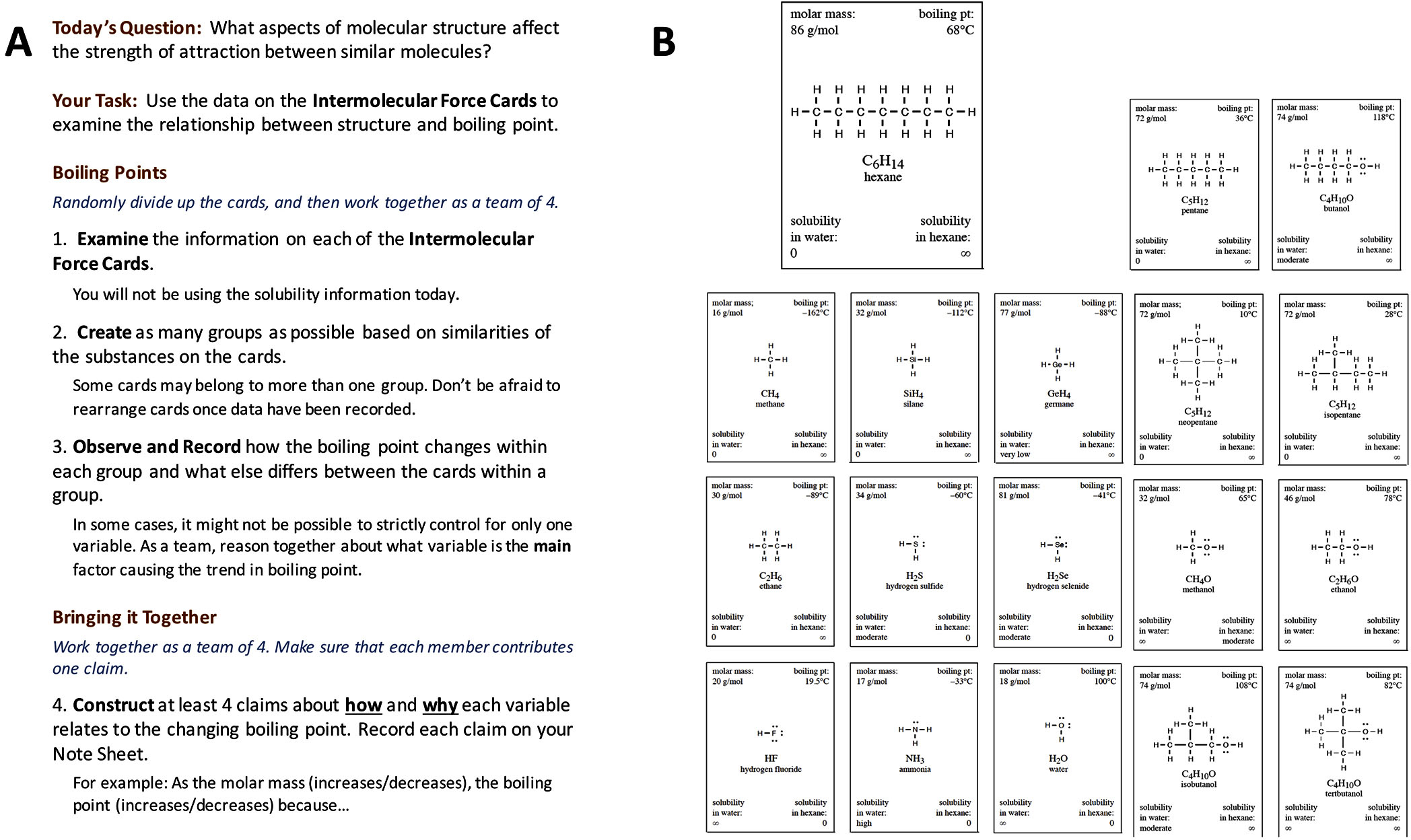
Task card and engineered data cards. (A) An example task card for a lesson on intermolecular forces. (B) Data cards include multiple representations of each substance and a variety of other data for students to analyze. The substances in this set of data cards were selected to allow students to organize and reorganize them in multiple ways and to see many different patterns.
In each of the three weekly class periods we provided teams with a chemical task card specifying the goals of the task along with data for collaborative sense-making (e.g., data tables, cards to sort, online simulations, and atomic-scale representations), and a note-sheet to organize and record the team’s thinking. The data representations were carefully engineered or selected to strike a balance between accessibility and complexity to challenge students, while inviting multiple ways of engagement (Figure 2B). The task card was designed to guide students’ use of the data for their investigations. An example of a task and its related data are shown in Figure 2 for a lesson about intermolecular forces. The task card begins with “Today’s Question,” which was designed to articulate what students would investigate that day, followed by a set of questions and suggestions to more directly guide the team as they explored the data. All of this work was to support students to create a team product (e.g., evidence-based arguments, predictions from models developed in the task, or explanatory drawings) called “Bringing it Together,” which required the team’s discussion and collective efforts.
One of the means of achieving our goal of providing students with a practice-based definition of science was the incorporation of “The Smart Things” list into the task launch (Figure 3A) (Cohen et al., 1999). This list provided explicit language about the practices necessary to complete a task that included chemical practices and norms to support equitable and collective participation. These lists were designed to highlight that the task—and science more broadly—requires a diversity of strengths that no one person carries alone. The task launch was also used to orient students to any new task-related tools and data. To highlight students’ participation in these practices, instructors tried to listen for the questions and connections teams made during the task and record them on whiteboards around the room (Figure 3B). To buttress the role of students as sense makers, instructors aimed to ask check-in questions (e.g., “What’s your team’s process been so far? What have you found challenging?”) and generally avoid giving students answers when responding to student questions. Finally, the task wrap up focused on connecting the task to “what scientists do” or “how chemists think” and featured some of the artifacts recorded on the whiteboards as a means of valuing students’ sensemaking.
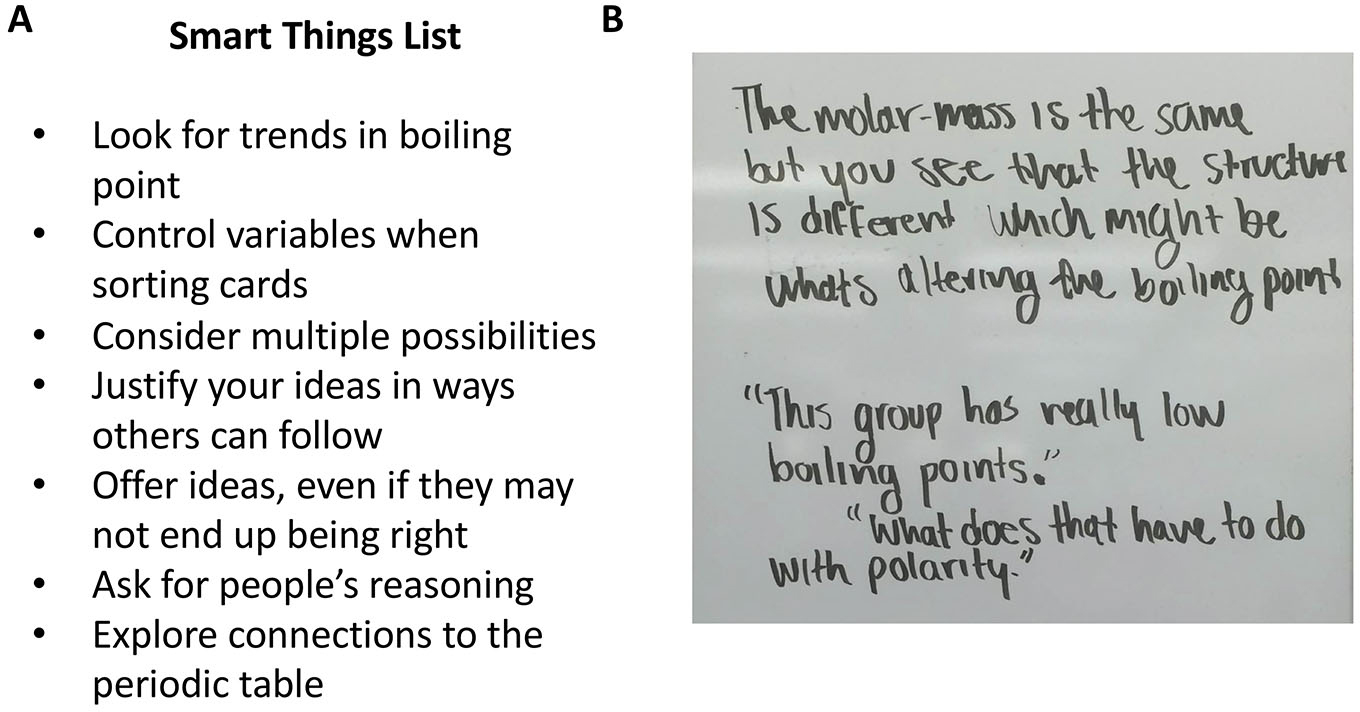
Reframing what counts as scientifically brilliant in class. (A) Smart Things List provided for the chemical task in Figure 2. This list was provided at the beginning of each class to provide an expansive list of practices that would be required for collective completion of the task. (B) Example of student quotes while they engaged in a task. These were recorded on whiteboards available throughout the classroom and were highlighted during the task closing to connect to the ways scientists think and what they do.
Assessments, grading practices, and messages
To continue to communicate our valuing of scientific practice and expansive definitions of competence, we employed our organizing principles in the design of our assessments, grading practices, and messaging about grades. Quizzes and exams consisted of sets of data-centered, interrelated questions that required students to draw on their conceptual understanding and practical skills (see https://www.nsta.org/college/connections.aspx). The Communicating Science assignments tasked students with composing posts to teach two audiences—their classroom community and their friends and family—about the chemistry of a compound relevant to human health and/or the environment. Each post included a picture and a caption (Figure 4). For their friends and family, students were encouraged to use informal language and make connections to their own and/or pop culture and were prohibited from including scientific language without definition. These assignments were designed to support students to develop fluency and flexibility in their ability to “talk science,” to view effective communication as an important scientific practice, and to apply their understanding in a relevant context (Lemke, 1990).
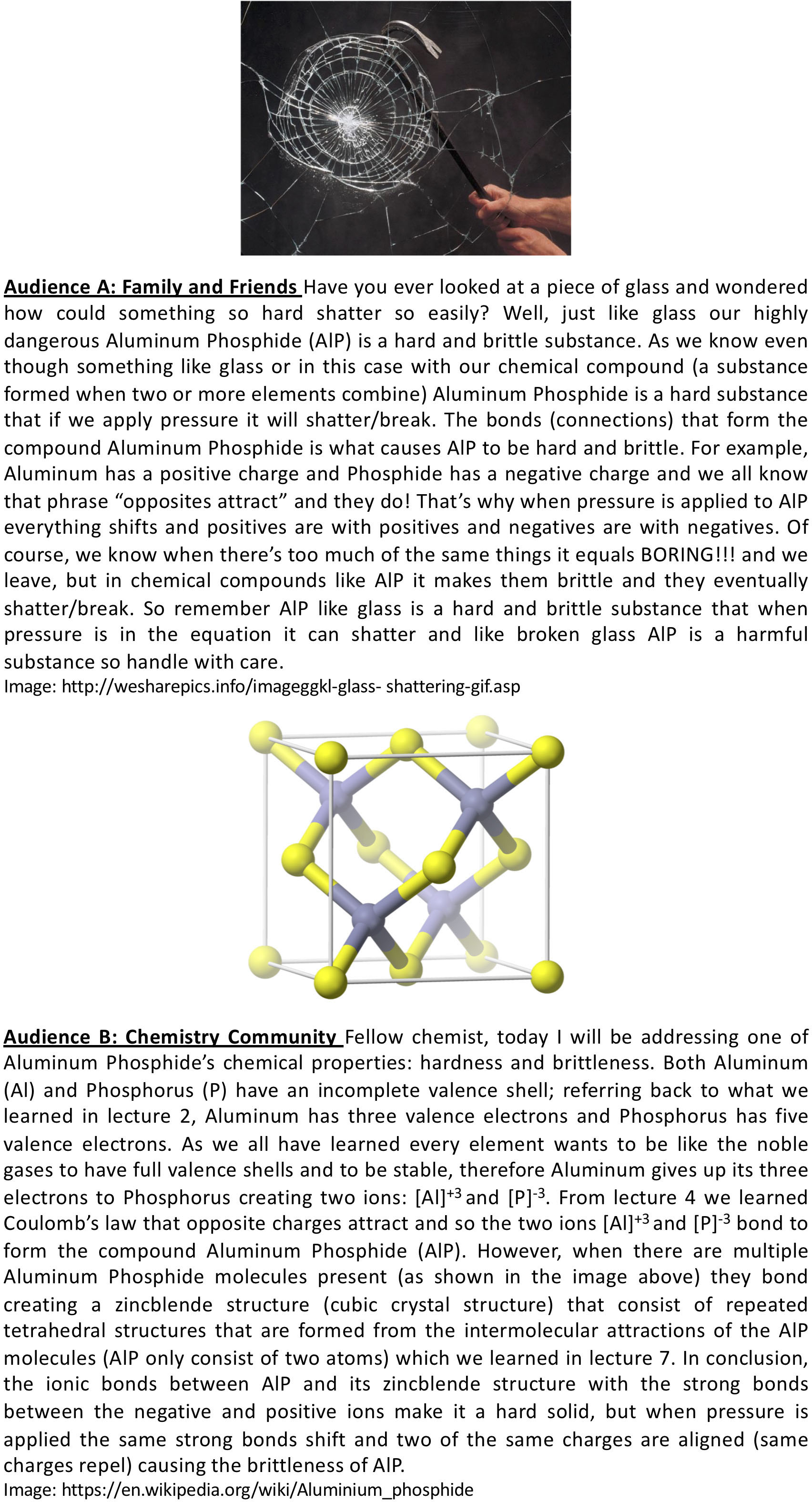
Sample student work for a Communicating Science assignment. For this assignment, students were asked to choose a property of their chosen substance and explain the structural characteristics that determine the chosen property.
In grading all assessments, we wanted to communicate our valuing of not only content knowledge, but also scientific process, so we designed rubrics to give full credit for normative chemical thinking, and partial credit for well-reasoned thinking that was only somewhat correct. Furthermore, to curtail high levels of competition between students, we used an absolute grading scale, did not publicize exam averages, and throughout the semester encouraged students to focus on how they could improve their performance as opposed to comparing their score to those of their peers.
Science skill reflections
While providing new definitions of learning and scientific competence along with new forms of participation in science, we also wanted to supply students with opportunities to contemplate their place in this new landscape. These opportunities came in the form of “The Science Skill Reflection” (Table 2), which prompted students to reflect on their experience with one of five skills central to doing science and the contributions of everyone on their team to the completion of tasks. These reflections furthered our work to provide expansive definitions of what it takes to be good at science, while also providing instructors with insight into students’ experiences and team dynamics. Students completed a total of four science skill reflections throughout the semester. We provided students with feedback about trends we noticed in their responses, including what students named as strengths and areas of growth, while making connections to our personal experiences and general experiences of scientists where appropriate. Providing this feedback allowed us to normalize struggle and celebrate triumphs experienced by students in the course.
| Table 2. Science skill reflection. | ||
|---|---|---|
|
Bringing it together
We contend that mitigating hierarchies in our classrooms that limit how students are seen, see themselves, and ultimately participate in science requires enlarging the landscape of what it means to be scientifically competent. In our redesigned course, we aimed to achieve this goal by communicating expansive meanings about what it means to be good at science—that align with science as it is practiced—and provide opportunities for students to engage in these practices in as many aspects of the course as possible. Structuring course design in this way has allowed us to engage students in constructivist pedagogies while inviting students such as Lee, Malik, and Kehlani (Figures 1B and 5) to see new possibilities for themselves in science (Carlone et al., 2011).
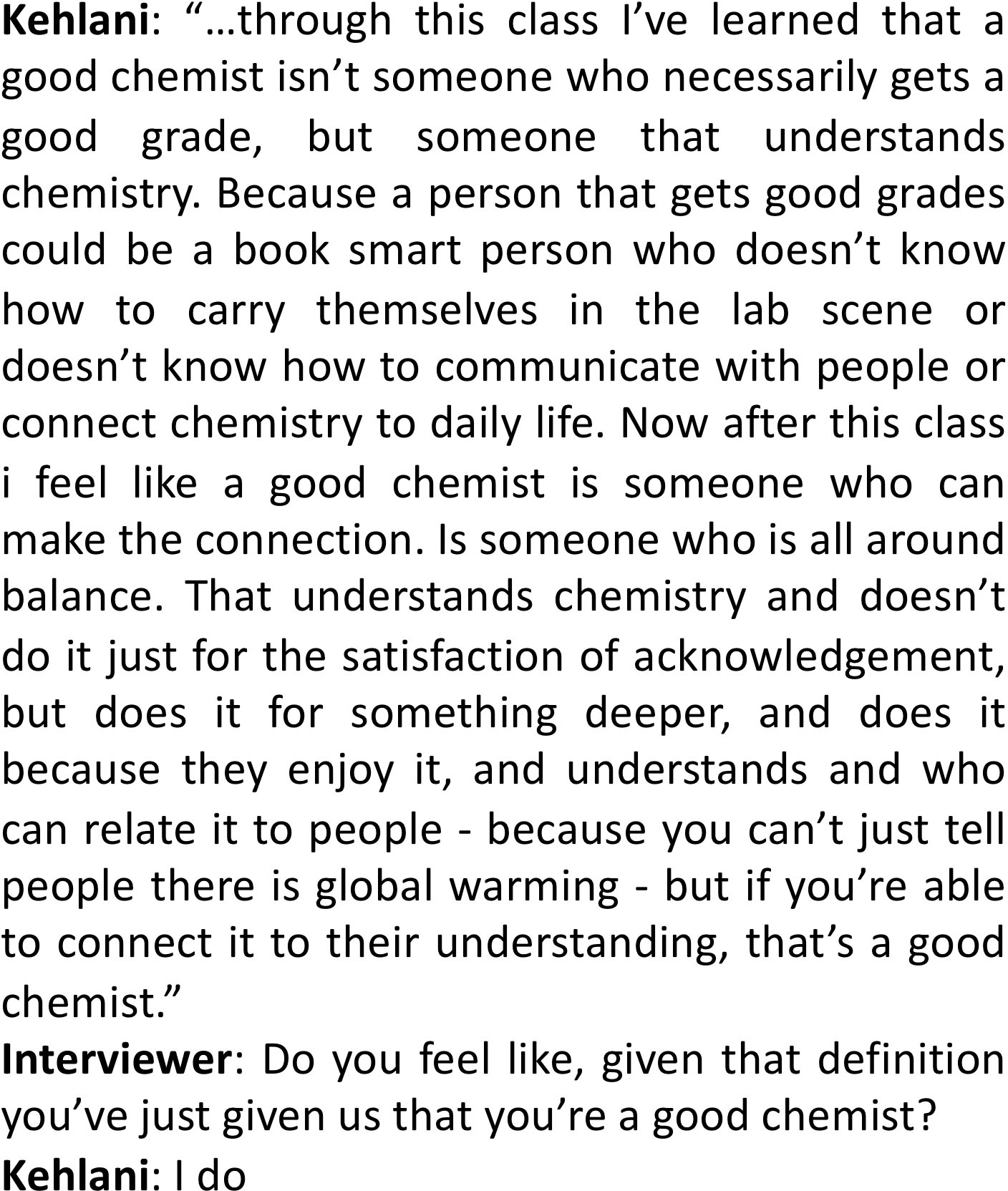
Example interview transcript of a student using a practice-centered definition of what it means to be good at chemistry and her identifying herself as such.
We used three sources of data to assess the influence of our design on students: video of groups working in class on chemical tasks, end-of-semester course reflections (n = 89), and semi-structured interviews (n = 21). Students were primarily selected to participate in the interviews if they consented to be video recorded; others were invited to participate to increase the diversity across gender, race, socioeconomic status, and their status as students repeating the course. All data were collected with the consent of the students in the fall 2016 semester, and all procedures were approved by the university’s Institutional Review Board for human subjects.
We analyzed video data to determine if the chemical tasks supported students to engage in scientific/chemical practices (Figure 6). The data included 352 minutes of video representing seven different teams participating in 10 different tasks. These videos were chosen because they allowed for representation of the diversity of tasks, and are distributed across the semester. Video analysis was done by creating and coding activity logs, which included summaries of participation, partial transcription, and observer comments made for every two or three minutes of activity. Codes for the observed practices were created inductively (see https://www.nsta.org/college/connections.aspx). This method of analysis is limited in that it only captures instances when students speak aloud; it cannot reliably capture every instance of engagement (e.g., organizing data), nor does it allow for accounting for exchanges between students. We find that the chemical tasks are supporting students to engage in a variety of scientific practices. We also find a relationship between the total number of instances of a given practice and its level of risk and complexity. For example, the most commonly observed practice is “asking chemical questions,” which is low risk compared to the other coded practices, but would be deemed high risk in a more traditional classroom. The least common practice, “challenging claims using evidence or reasoning,” is arguably the most risky and complex practice because it requires students to engage in multiple scientific practices while being confident enough to push back on a peer’s idea. We attribute the variability in the total number of practices observed for each task to differences in task structure and group dynamics.
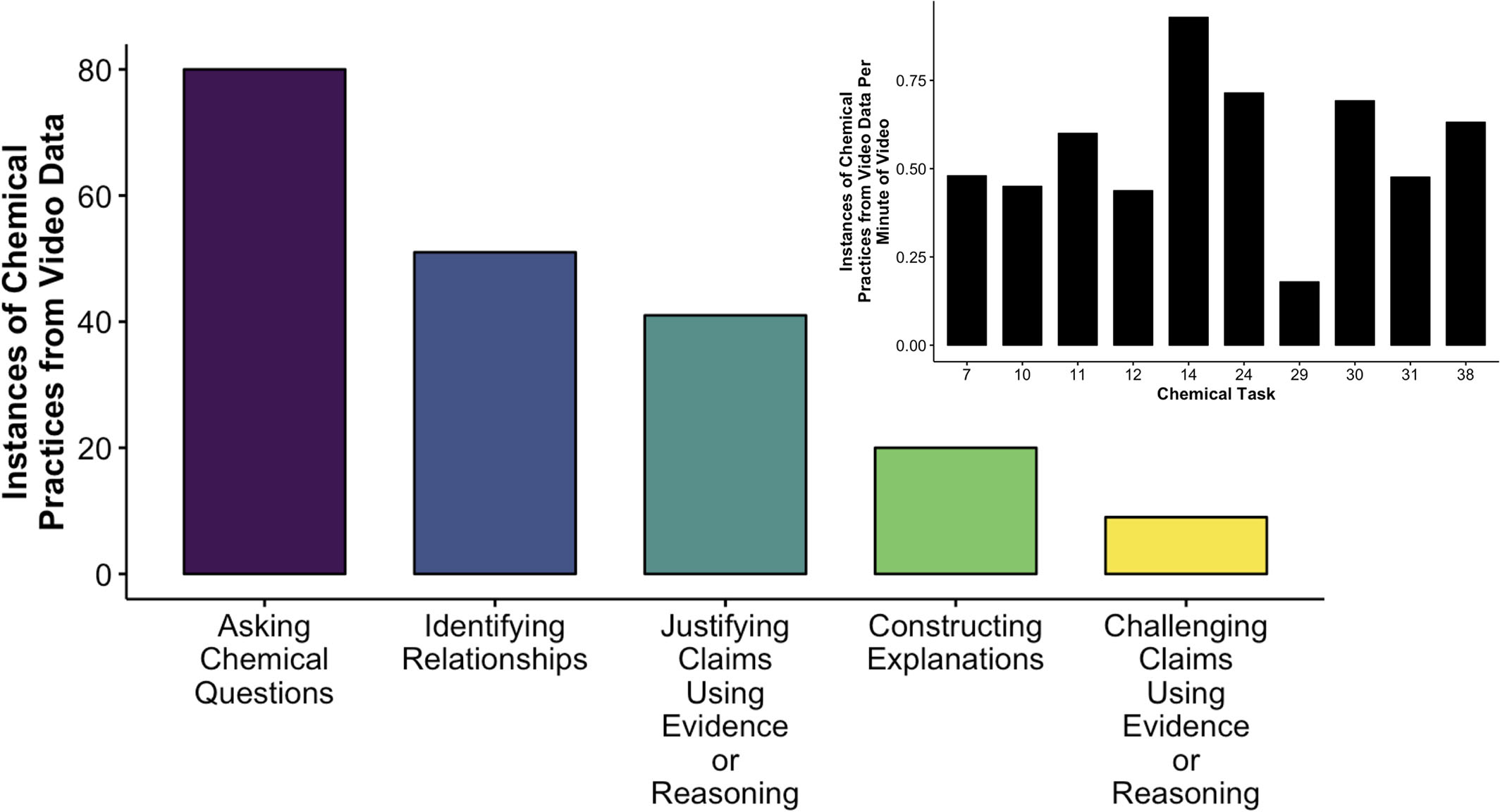
Analysis of in-class video data. Video data from seven teams engaging in 10 different chemical tasks. Analysis of the instances of students engaging in scientific practices. Inset: The number of observed practices per minute of video.
We turned to the end-of-semester reflections and interviews to assess students’ prior conceptions of what it means to be good at chemistry and to determine if students took up our practice-centered definitions of chemical competence. Students’ reflections were a response to the following prompt: “How has [the redesigned course] changed, challenged, or confirmed your ideas about what it takes to think like a chemist?” From interviews, we analyzed students’ response to: “What does it mean to be good at chemistry in the [redesigned course]?” Both sources of data were analyzed using the same set of inductively created codes (see https://www.nsta.org/college/connections.aspx). Of the 89 student responses available for analysis, 35 students did not explicitly articulate a prior conception of “good at chemistry.” Of the remaining 49 students, 47 defined their conception of being good at chemistry based on experiences prior to taking the redesigned course using prototypical definitions such as “knowing a lot of information” or “getting good grades.” The five remaining responses either defined chemistry (e.g., “Chemistry is a cumulative science…”), or refer to their feelings about learning chemistry (e.g., “Chemistry was extremely boring…”). However, of the 71 students who articulated what it meant to be “good at chemistry” in our redesigned course, nearly all (99%, n = 70) used practice-centered definitions (Figure 7). These data suggest that participation in the course supports a major shift in how students define chemical competence.
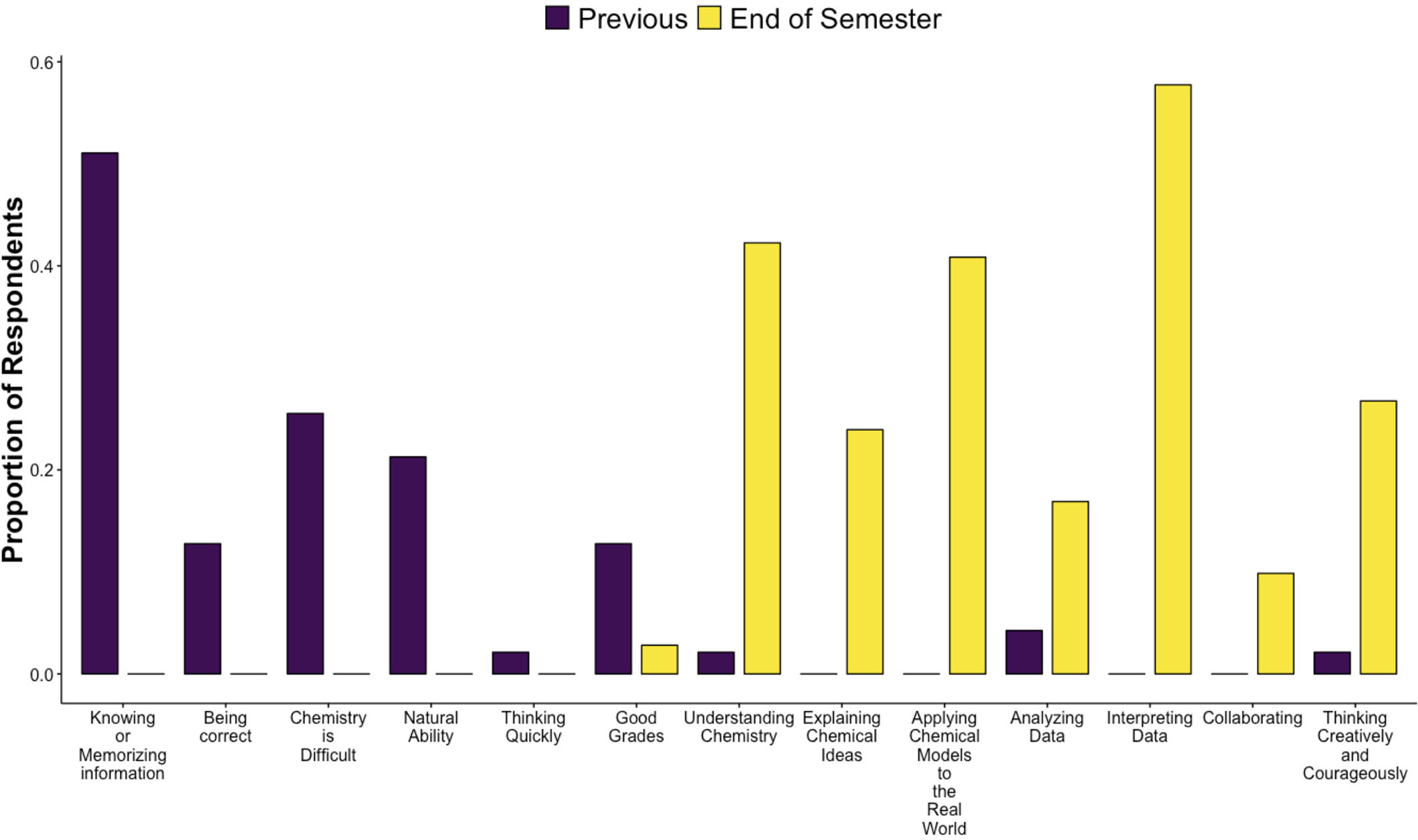
Student perceptions of what it means to be “good at chemistry” shift to practice-centered definitions by the end of the semester. Student responses to end-of-semester reflections or during interviews inquiring about students previous and current perceptions of what is required for chemical competence. Codes used from Table 2.
We not only wanted students to have a more expansive definition of “good at chemistry,” but to also recognize themselves as such. Therefore, during interviews students were asked, “Given your definition of what it means to be ‘good at chemistry,’ are you someone who is good at chemistry?” In Figure 5, Kehlani, a student who previously withdrew from the traditional course, describes her practice-centered definition of what it means to be “good at chemistry” and uses it to identify herself as “good.” When looking across all of the interviews, we find a rather interesting pattern: Students who expressed a practice-only definition of what it means to be good at chemistry saw themselves as “good” at chemistry. However, students whose definitions included grades—either exclusively or in addition to practice—did not see themselves as chemically competent (Figure 8). Furthermore, there appears to be no correlation between students identifying as being good at chemistry and their grades, as those who see themselves as good at chemistry have grades ranging from A–D. These data suggest that when students are provided an expansive definition of science, they are more likely to see themselves as people who are capable and competent science learners and doers. These data also suggest that the course may support or maintain students’ self-efficacy and science identity, two factors known to support persistence in STEM (Estrada et al., 2011)

Relationship between students’ definition of what it means to be “good at chemistry” and how they identify themselves. Data from end-of-semester interviews (n = 21).
Dewsbury and Brame assert that “inclusivity implies an intentional practice of recognizing and working to mitigate biases that lead to marginalization or exclusion of some people” (Dewsbury & Brame, 2019). Altogether, our data suggest that one way to achieve inclusivity in the classroom is to re-culture our courses, ensuring that students are engaging in numerous scientific practices while explicitly naming an expansive list of these practices as being central to science. Doing this allowed our students to see themselves and science in new and powerful ways that, for many of them, pushed against their original and limited understanding of what and who counts as scientifically competent. Central to this work is knowing that all of our students enter our classrooms as talented, capable, and competent learners, and understanding that the work of the instructor is to surface, leverage, and develop this talent.
Sabriya N. Rosemond (srosemond@berkeley.edu) is the assistant director of the Learning Assistant Program at Florida International University in Miami, Florida. Erin S. Palmer is an assistant professor of chemistry at Diablo Valley College in Pleasant Hill, California. Kelly C. Y. Wong is a chemical biology graduate student at the University of California, Los Angeles in Los Angeles, California. Vishnu Murthy is a medical student at the David Geffen School of Medicine at the University of California, Los Angeles. Angelica M. Stacy is professor emerita of chemistry and science education at the University of California, Berkeley in Berkeley, California.
Chemistry Equity Teaching Strategies Postsecondary



